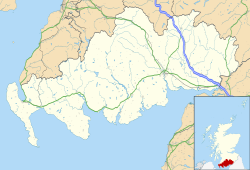Kirkconnel
| |
|---|---|
 A76 entering Kirkconnel | |
Location within Dumfries and Galloway | |
| Population | 1,970 (2020) [a] [1] |
| Language | English Scots |
| OS grid reference | NS7311 |
| • Edinburgh | 50 miles (80 km) NE |
| • London | 312 miles (502 km) SSE |
| Council area | |
| Lieutenancy area | |
| Country | Scotland |
| Sovereign state | United Kingdom |
| Post town | SANQUHAR |
| Postcode district | DG4 |
| Dialling code | 01659 |
| Police | Scotland |
| Fire | Scottish |
| Ambulance | Scottish |
| UK Parliament | |
| Scottish Parliament | |
Kirkconnel (Gaelic: Cille Chonbhaill) is a small parish in Dumfries and Galloway, southwestern Scotland. It is located on the A76 near the head of Nithsdale. Principally it was a mining community thriving until the late 1960s when the local mine, Fauldhead colliery closed. It has strong ties to football. The name comes from The Church of Saint Conal. In 1850 the village had only a single street. Next to Kirkconnel is a separate village called Kelloholm.
Contents
It is also associated with the ballad Helen of Kirkconnel .
